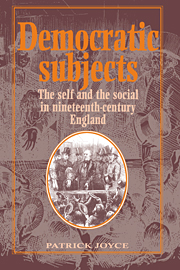Book contents
- Frontmatter
- Contents
- List of plates
- Acknowledgements
- Introduction
- Part One The sorrows of Edwin Waugh: a study in ‘working-class’ identity
- 1 Young Edwin
- 2 The struggle for the moral life
- 3 The ends of the moral life
- 4 The cult of the heart
- 5 ‘God bless these poor folks’
- 6 The legacy of Edwin Waugh
- Part Two John Bright and the English people: a study in ‘middle-class’ identity
- Part Three Democratic romances: narrative as collective identity in nineteenth-century England
- Appendices
- Index
6 - The legacy of Edwin Waugh
Published online by Cambridge University Press: 10 December 2009
- Frontmatter
- Contents
- List of plates
- Acknowledgements
- Introduction
- Part One The sorrows of Edwin Waugh: a study in ‘working-class’ identity
- 1 Young Edwin
- 2 The struggle for the moral life
- 3 The ends of the moral life
- 4 The cult of the heart
- 5 ‘God bless these poor folks’
- 6 The legacy of Edwin Waugh
- Part Two John Bright and the English people: a study in ‘middle-class’ identity
- Part Three Democratic romances: narrative as collective identity in nineteenth-century England
- Appendices
- Index
Summary
John Hartley was born in 1839, the son of a travelling draper and tea-dealer. His background and development were similar to Waugh in many respects, similar also to many among the ranks of the plebeian intellectual and artist. Though he lived through extreme poverty in his youth, there is the same background of small-scale economic independency in his father's trade. There is the same strong religious background on his mother's side (she was a Quakeress); the same legacy of artistic accomplishment. His grandparents were very active in Illingworth choir (Illingworth was a village outside Bradford, of a very similar kind to the domestic-industrial-agricultural environment Waugh grew up in). A mill half-timer, he became a full-timer at twelve, like Waugh taking up an occupation that permitted an opening to the high-cultural worlds beyond the workshop, in this case training to be a designer of worsted tapestries at the works of James Ackroyd and Sons.
He practised singing, reciting, speechmaking, and music at the Beacon Club near his home in Halifax, a young men's mutual improvement society of a sort very common at this time. In 1872 he threw up his job at Akroyd's and became a ‘bohemian’, travelling and working in the US and Canada.
- Type
- Chapter
- Information
- Democratic SubjectsThe Self and the Social in Nineteenth-Century England, pp. 72 - 82Publisher: Cambridge University PressPrint publication year: 1994



